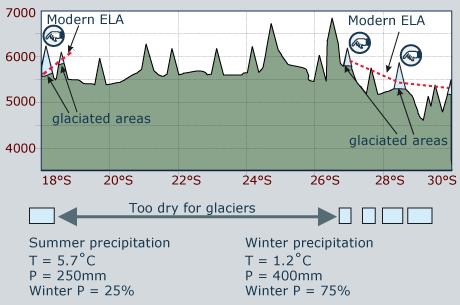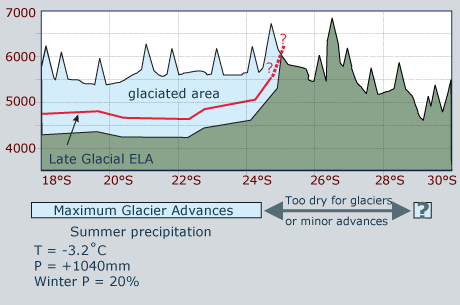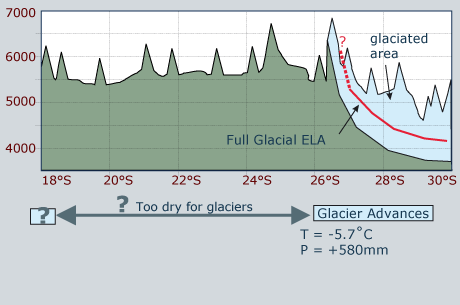| Modern climate conditions |
|

1 - Modern conditions
|
| Late Glacial climate |

2 - Late Glacial (about 12,000 yr BP)
|
| Full glacial climate |
|

3 - Full glacial time (about 20,000 yr BP)
|
|
| This region in the North Chilean Andes represents
the transition zone between the tropics and the extra-tropics in
South America. During the summer season, precipitation generally
emerges from convective activity over the northern region (about
18° to 23° S), due to the influx of warm and humid tropical
air masses.
South of 23° S, summer rainfall activity quickly decreases.
Therefore, summer rainfall occurs mainly in the northern region.
In winter, frontal systems of the Westerlies are abundant south
of 27° S, but further north, few events occur. Between 19°
and 27° S, the temperatures would be low enough for the built-up
of glaciers, but precipitation is lacking.
These seasonal patterns explain modern glaciation well, with tropical
glaciers around 18° S, and the extratropical glaciers between
27° and 29° S.
|
| The Altiplano of northern Chile in the region of
18 to 24° S was heavily glaciated during late-glacial times.
Regional temperature depressions of –1.8 to –3.0°
C were calculated by the model of Kull et al. (2002). Hence, moderately
cold but very humid conditions triggered maximum advances in the
tropical part of Chile, implying large meridional fluctuations of
the tropical summer precipitation regime toward the South. In the
southern part from 27° to 29° S, glaciation seemed not have
been stronger, implying that there was no intensification of the
Westerlies.
The core area of the Atacama Desert between 25 and 27°S was
most probably not affected by late-glacial moisture changes.
|
| The glaciers in the southern area (27° to 29°
S) developed during cold and moderately humid conditions. These
results are consistent with findings from South-Central Chile(33°-
43° S), where the maximum glacier expansion is documented for
full glacial times and reconstructed temperature depressions are
in a comparable range.
The fact that the northern boundary of the modern
and the Last Glacial Maximum glaciation is found at the same latitude
suggests that the northern boundary of the Westerlies did not shift
towards lower latitudes, but remained very stable in its current
position, although intensified and with much steeper meridional
gradients. Tropical moisture, feeding the region north of 23°S,
seems to have been reduced. |
|



